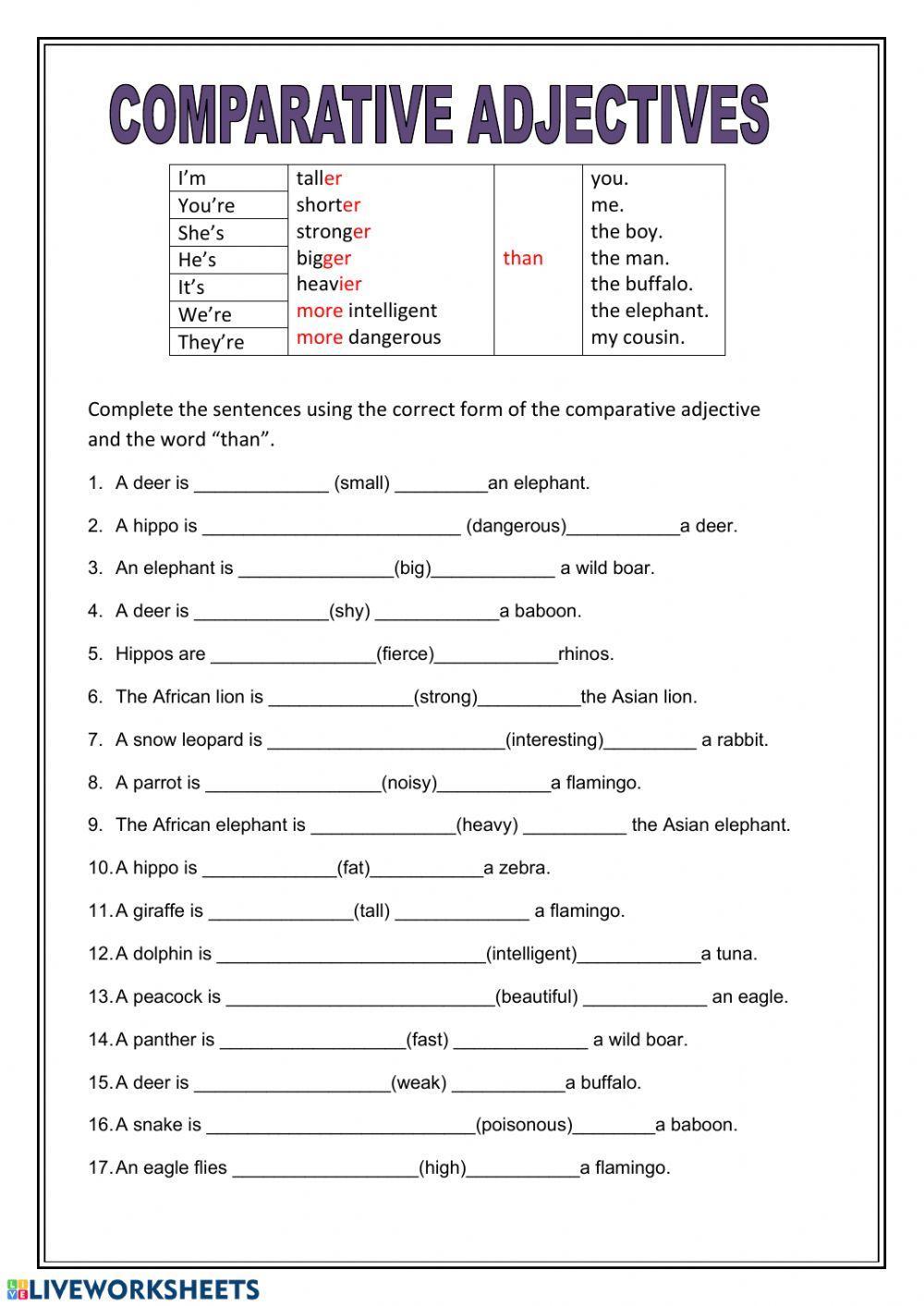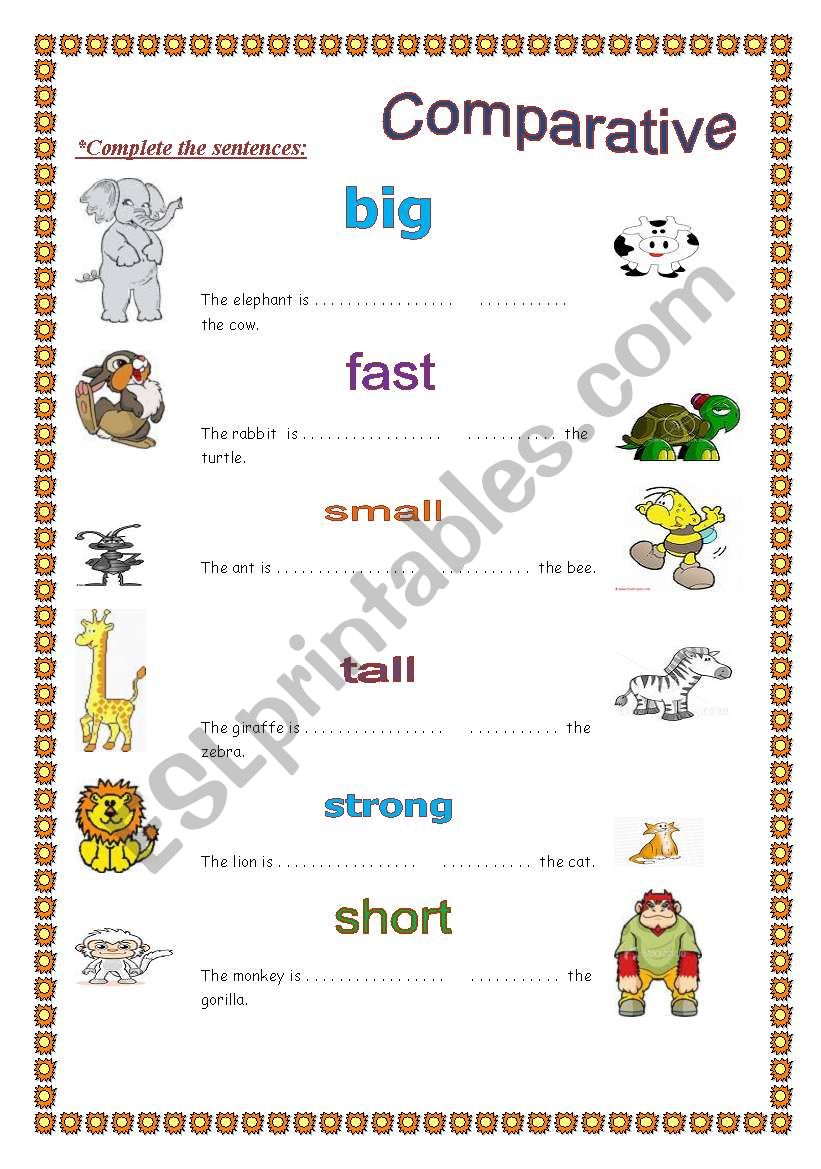
Mastering Differences: The Power of Grammar Worksheets: Comparatives
In the intricate tapestry of language, grammar serves as the essential framework, allowing us to construct meaning, express nuances, and communicate effectively. Among the many grammatical concepts, comparatives hold a unique and frequently used position. They enable us to articulate distinctions, highlight preferences, and describe the world around us in terms of relative qualities. Whether we’re discussing which car is faster, which book is more interesting, or which path is safer, comparative adjectives and adverbs are indispensable. For learners of English, grasping this concept thoroughly is crucial for both fluency and accuracy. This is where Grammar Worksheets: Comparatives emerge as an invaluable tool, providing structured practice and reinforcing understanding in a systematic manner.
The Foundation: Understanding Comparatives
Before delving into the utility of worksheets, it’s essential to first understand what comparatives are and how they function. Comparative forms are used to compare two things, people, or groups. They answer the question "which one is more [adjective/adverb]?" or "how is this different from that?"

The Basic Rules:

- Short Adjectives/Adverbs (one or two syllables ending in -y): Add "-er" to the end.
- Examples: old → older, fast → faster, happy → happier, easy → easier.

- Longer Adjectives/Adverbs (two or more syllables not ending in -y): Use "more" before the adjective/adverb.
- Examples: beautiful → more beautiful, intelligent → more intelligent, slowly → more slowly, difficult → more difficult.



Spelling Rules for "-er":
- Silent ‘e’: If the adjective ends in a silent ‘e’, just add ‘r’. (large → larger, wise → wiser)
- Consonant + Vowel + Consonant: Double the final consonant before adding ‘-er’. (big → bigger, hot → hotter, thin → thinner)
- Ends in ‘y’: Change ‘y’ to ‘i’ before adding ‘-er’. (happy → happier, easy → easier, funny → funnier)


Irregular Comparatives:
Some common adjectives and adverbs have irregular comparative forms that do not follow the standard rules. These must be memorized.
- good → better
- bad → worse
- far → farther/further
- little → less
- much/many → more
Using "than": When comparing two specific items, the word "than" is typically used after the comparative form.
- Example: My car is faster than yours. This book is more interesting than that one.
Understanding these foundational rules is the first step. However, passive knowledge is rarely enough for mastery. Active application and repeated practice are key, and this is precisely where Grammar Worksheets: Comparatives prove their worth.
The Indispensable Role of Grammar Worksheets: Comparatives
In the realm of language acquisition, worksheets are often the unsung heroes. They transform abstract grammatical rules into tangible exercises, allowing learners to apply what they’ve learned and solidify their understanding. For comparatives, which involve both rule application and some memorization, the structured practice offered by worksheets is particularly beneficial.
The true power of Grammar Worksheets: Comparatives lies in their ability to:
- Provide Targeted Practice: Worksheets focus specifically on comparatives, ensuring that learners are repeatedly exposed to the rules and their variations. This targeted approach helps to isolate the concept and prevent confusion with other grammatical structures.
- Reinforce Rules and Patterns: Through repeated exercises, the rules for forming comparatives (adding -er, using "more," spelling changes, irregular forms) become ingrained. This repetition is crucial for moving from conscious application to automatic usage.
- Identify Knowledge Gaps: When learners struggle with a particular type of exercise or a specific irregular form, worksheets immediately highlight these areas of weakness. This allows teachers to provide focused intervention or learners to review specific rules.
- Build Confidence: Successfully completing exercises on a worksheet provides a sense of accomplishment. This positive reinforcement encourages learners and builds their confidence in using comparatives correctly.
- Offer Self-Correction Opportunities: Many worksheets come with answer keys, enabling learners to check their own work. This promotes independent learning and allows for immediate feedback, which is vital for effective skill acquisition.
- Support Differentiated Learning: Worksheets can be designed with varying levels of difficulty, catering to diverse learning needs within a classroom. Beginners might start with simple fill-in-the-blanks, while advanced learners could tackle error correction or sentence transformation tasks.
- Serve as Assessment Tools: For educators, Grammar Worksheets: Comparatives can serve as quick formative assessments, providing insights into student comprehension and informing future lesson planning.
Types of Effective Grammar Worksheets: Comparatives
The effectiveness of worksheets depends heavily on their design and the variety of exercises they offer. A good set of Grammar Worksheets: Comparatives should go beyond simple rote memorization and encourage deeper processing. Here are some common and effective types:
-
Fill-in-the-Blanks:
- Description: Sentences with a blank space where the comparative form of a given adjective/adverb needs to be inserted.
- Example: "The elephant is ____ (big) than the mouse."
- Benefit: Excellent for initial practice, directly testing the application of the basic rules.
-
Sentence Transformation:
- Description: Learners are given a sentence (or two separate sentences) and asked to rewrite it using a comparative form.
- Example: "My house is old. Your house is new. → My house is ____ than yours." or "New York is a big city. London is also a big city, but New York is bigger."
- Benefit: Encourages active construction and understanding of how comparatives fit into sentence structure.
-
Error Correction:
- Description: Sentences containing grammatical errors related to comparatives. Learners identify and correct the mistakes.
- Example: "She is more taller than her brother." (Correction: She is taller than her brother.)
- Benefit: Develops critical thinking skills and a deeper understanding of common pitfalls. It makes learners active editors of language.
-
Multiple Choice:
- Description: Sentences with a blank space and several comparative options to choose from.
- Example: "This movie is _____ than the last one. (a) more boring (b) boringer (c) most boring)"
- Benefit: Good for quick checks of understanding and for distinguishing between correct and incorrect forms.
-
Matching Exercises:
- Description: Matching an adjective/adverb with its correct comparative form, or matching a descriptive phrase with a comparative sentence.
- Example: Match "good" with "better," or "A cheetah runs quickly" with "A cheetah runs faster than a lion."
- Benefit: Reinforces memorization of irregular forms and provides a different way to engage with the vocabulary.
-
Picture-Based Comparisons:
- Description: Learners are shown two or more pictures and asked to write comparative sentences describing the differences.
- Example: Pictures of a small car and a large truck. Learners write: "The truck is bigger than the car." or "The car is smaller than the truck."
- Benefit: Connects language to visual input, making it more engaging and realistic. Ideal for visual learners.
-
Short Paragraph/Story Completion:
- Description: A short text with blanks that require comparative forms to complete the narrative.
- Benefit: Places comparatives in a contextualized setting, helping learners see their natural use in longer stretches of text.
Designing and Utilizing High-Impact Grammar Worksheets: Comparatives
Creating or selecting effective worksheets isn’t just about throwing exercises together; it requires thoughtful consideration.
Tips for Designing Worksheets:
- Clarity of Instructions: Ensure instructions are simple, concise, and easy to understand.
- Variety of Exercises: Mix and match different types of exercises to keep learners engaged and test different aspects of understanding.
- Scaffolding: Start with easier exercises and gradually increase difficulty. For instance, begin with short adjectives, then move to longer ones, and finally introduce irregular forms.
- Contextualization: Whenever possible, use sentences and scenarios that are relatable and interesting to the target audience. Abstract sentences can be less engaging.
- Visual Appeal: Use clear fonts, adequate spacing, and perhaps some relevant images to make the worksheet visually appealing and less daunting.
- Answer Key: Provide a clear answer key, either separately or at the back, to facilitate self-correction.
Tips for Utilizing Worksheets Effectively:
- Pre-Assessment: Use a short worksheet at the beginning of a lesson to gauge learners’ prior knowledge of comparatives.
- In-Class Practice: Worksheets can be used for individual practice, pair work, or small group activities. Encourage learners to discuss their answers.
- Homework: Assign worksheets as homework to reinforce learning outside the classroom.
- Review and Reinforcement: Use worksheets as a quick review before a test or at the start of a subsequent lesson.
- Differentiation: Assign different worksheets or sections of a worksheet to learners based on their proficiency levels.
- Feedback and Correction: Go over answers as a class, explaining common mistakes and providing constructive feedback. Don’t just provide the correct answers; explain why they are correct.
Beyond the Paper: Integrating Technology and Real-World Application
While traditional paper-based Grammar Worksheets: Comparatives are incredibly effective, their utility can be enhanced by integrating technology and connecting the concept to real-world communication.
- Online Interactive Worksheets: Many websites offer interactive exercises where learners can type answers and receive instant feedback. These often incorporate gamification elements, making learning more enjoyable.
- Worksheet Generators: Teachers can use online tools to quickly generate customized worksheets based on specific comparative rules or vocabulary.
- Linking to Speaking Activities: After completing a worksheet, encourage learners to use comparatives in conversation. For example, "Look at these two pictures. Tell me three ways they are different using comparatives." or "Compare two friends in the class using different adjectives."
- Connecting to Writing Tasks: Assign writing tasks that naturally require the use of comparatives, such as comparing two cities, two products, or two characters from a story. This helps learners see the practical application of the grammar.
- Real-World Examples: Point out comparatives in everyday language – advertisements ("Our soap is cleaner!"), news headlines ("Economy is stronger than expected!"), or conversations.
Conclusion
The ability to compare and contrast is fundamental to human communication, and mastering comparative adjectives and adverbs is a cornerstone of English fluency. While understanding the rules is the starting point, true mastery comes through consistent and varied practice. This is precisely where Grammar Worksheets: Comparatives shine as an indispensable resource. They offer a structured, targeted, and effective way for learners to internalize complex rules, build confidence, and ultimately use comparatives naturally and accurately in both spoken and written English. By embracing the diverse types of exercises and employing thoughtful design and utilization strategies, educators and learners alike can harness the full power of these worksheets to unlock a richer, more nuanced command of the English language.
